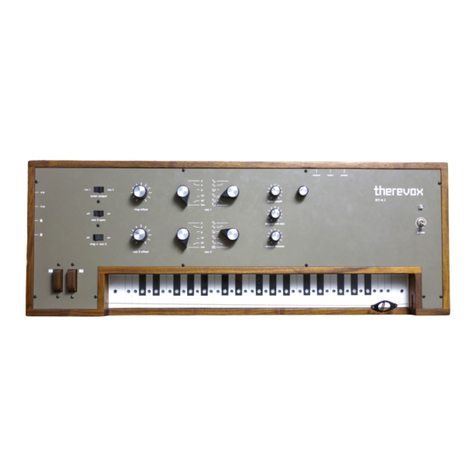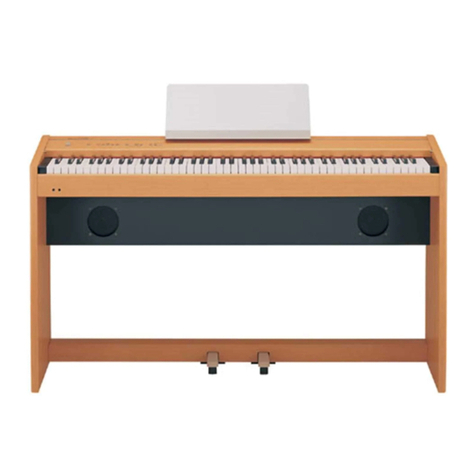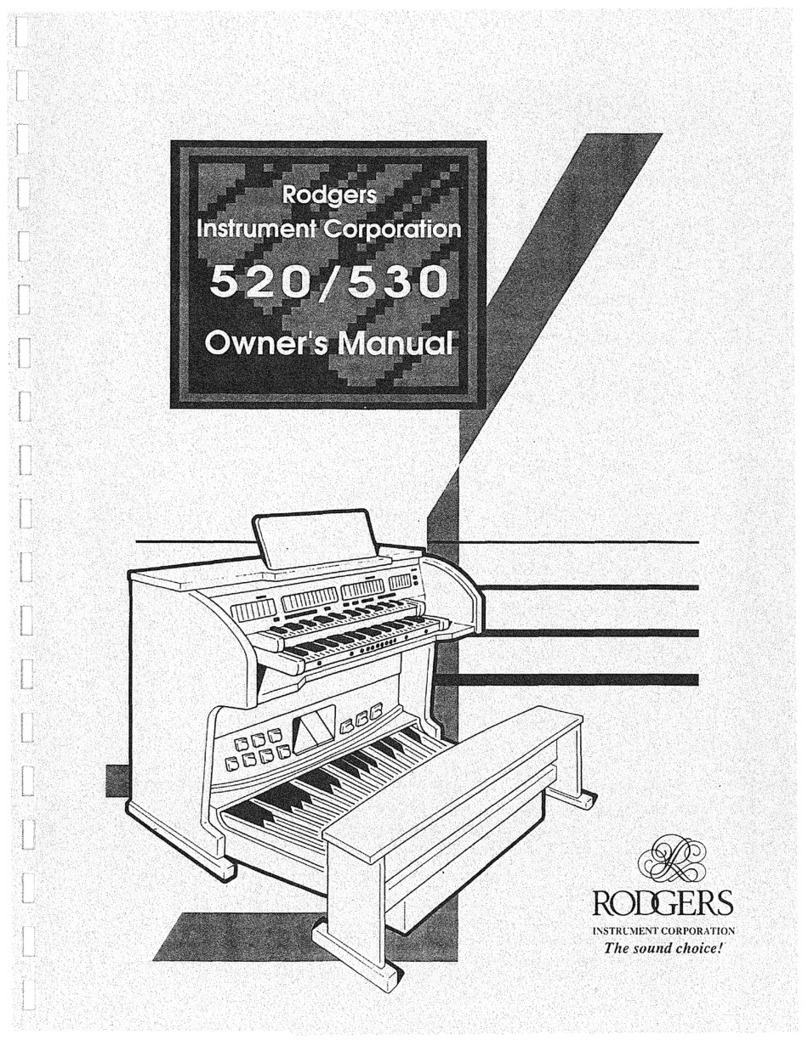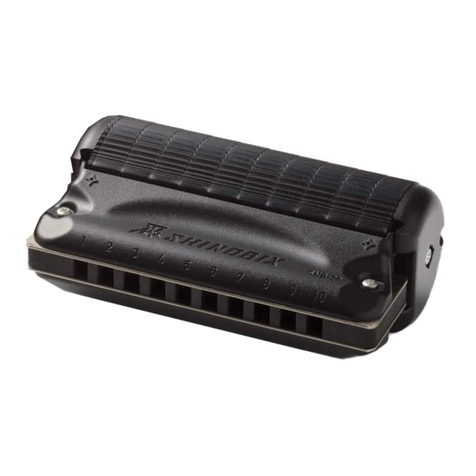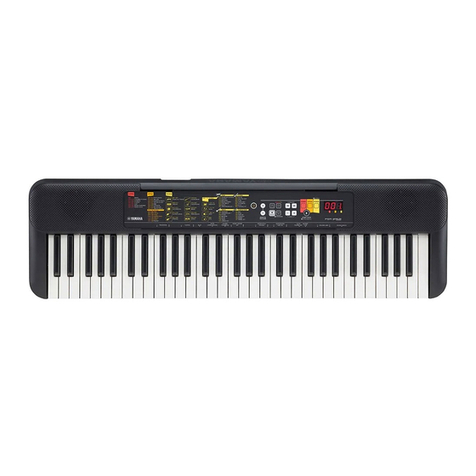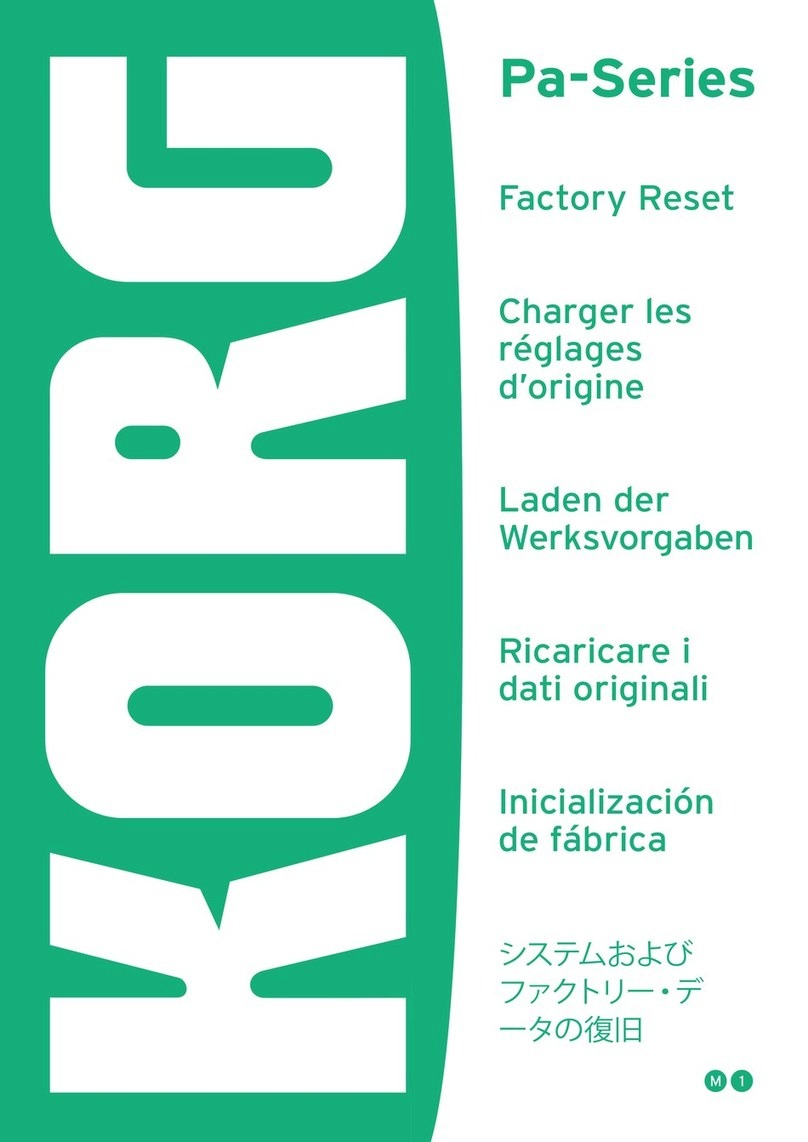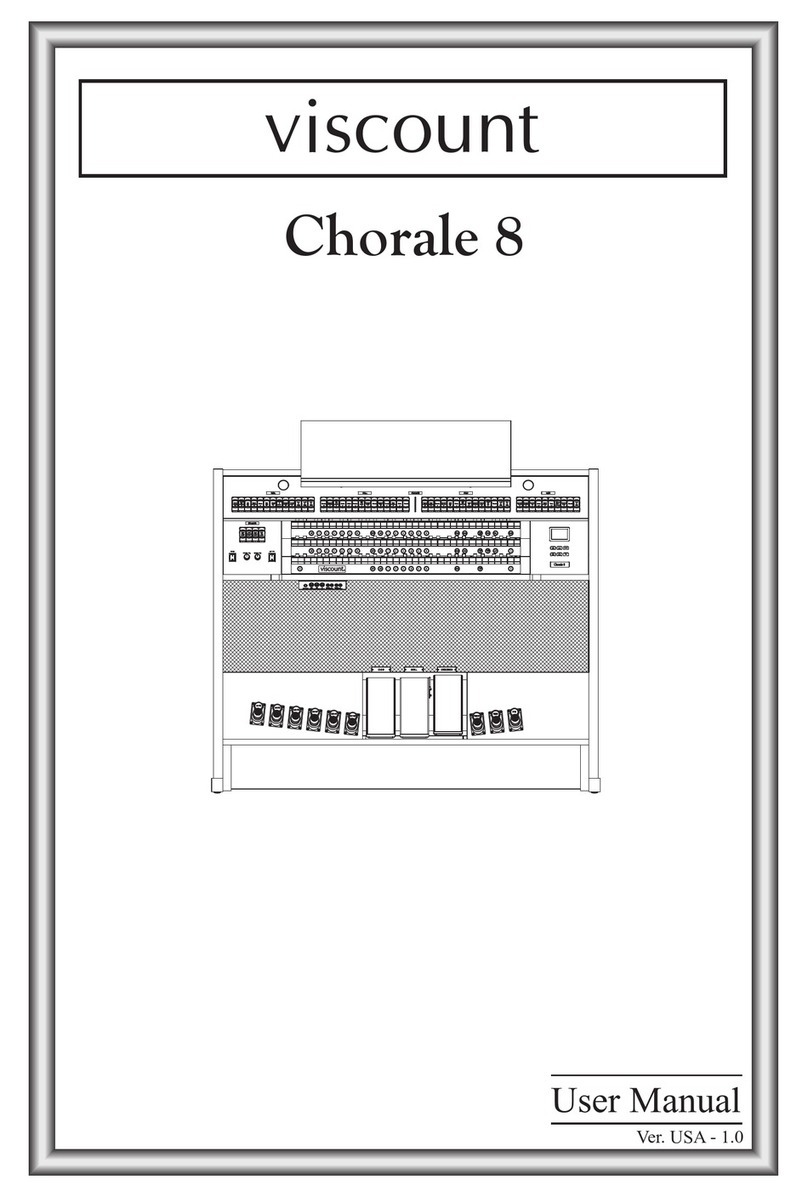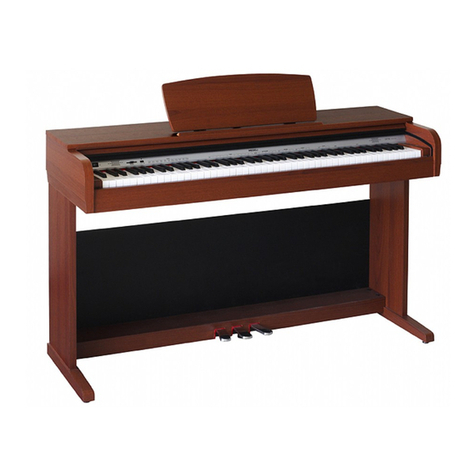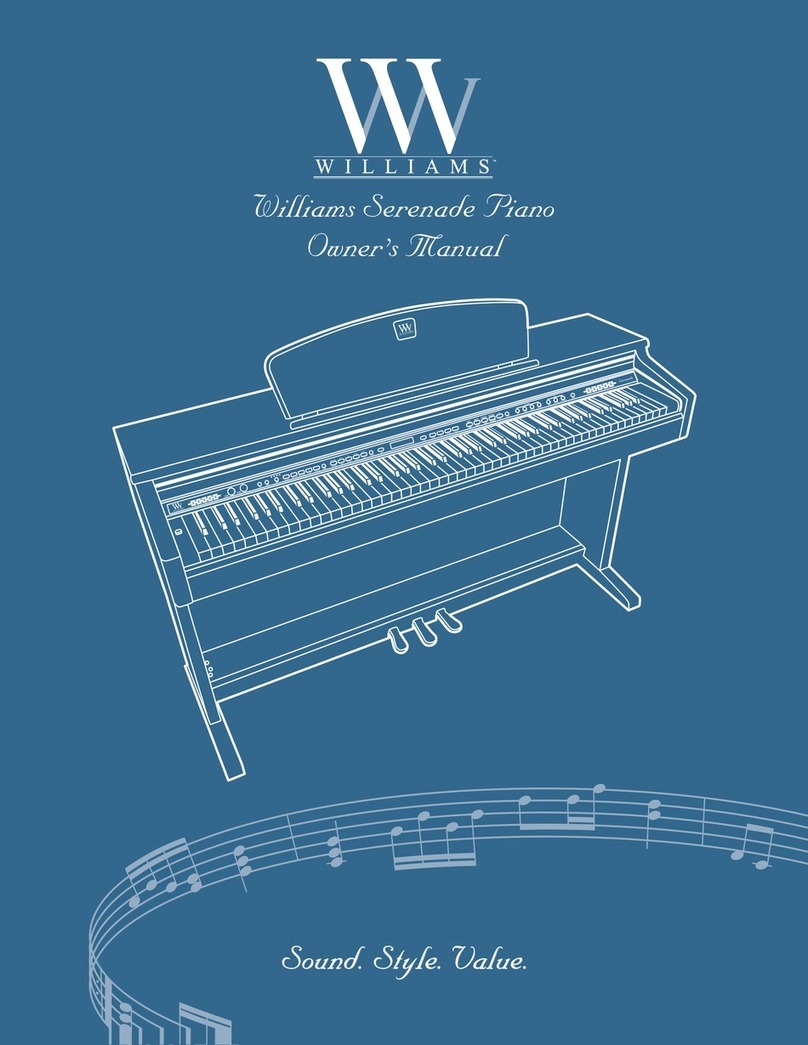therevox ET-4.2 User manual

ET-4.2
user manual

ET-4.2
user manual
Therevox builds custom musical
instruments in Tecumseh Ontario Canada.
The ET-4.2 was designed and constructed
by Mike Beauchamp and Melissa
Damphouse with heaps of support from
family, friends and our customers.
therevox.com
info@therevox.com
Made in Canada

Playing
Switches
Oscillators
Filter and Reverb
Effects Loop and Phones
Power and Outputs
Exp and CV Jacks
Care
Technical Info
1
3
4
6
7
8
9
11
12
contents

playing
1
The ET-4.2 is a continuous pitch analog instrument. Sounds are
produced by two oscillators, each producing six different waveforms.
A low-pass filter and spring reverb allow for further sonic goodness.
The pitch of the instrument is controlled by the ring and the
amplitude of each oscillator is controlled by the pressure sensitive
intensity keys.

switches
3
sync off sync on
osc 1
osc 2
tuner output
osc 2
osc 1
osc 2 sync
off on
ring osc 2
off on
A tuner can be connected to silently verify and
modify tuning of either oscillator at any time.
The tuner output switch selects which
oscillator to tune.
Synching oscillator 2 will force the waveform
to reset at the same pitch as oscillator 1.
The pitch of oscillator 2 can follow the ring or
be disconnected from it using the ring > osc 2
switch. Disabling this allows oscillator 2 to be
set to a consistent pitch.
The RingThe Keys
2
By varying the pressure on each of
the intensity keys, you create
amplitude envelopes for each of the
oscillators.
Use these separately to switch
between different voices, or mix the
oscillators together creating unique
sounds.
The ring controls the pitch of the
oscillators. The reference keyboard
allows you to point to notes and
everything in between.
The ring can be adjusted to fit
comfortably between the first and
second knuckle by moving the
rubber retainer to a different notch.

ring offset
osc 2 offset
2'
4'
8'
16'
low
32'
2'
4'
8'
16'
low
32'
osc 1
osc 2
oscillators
Sine Wave
Triangle Wave
Rectified Sine
Square Wave
30% Pulse
10% Pulse
White Noise
4 5
Ring offset is the master tuning control for both
oscillators and the external ring CV.
Oscillator 2 can be tuned independently using the
osc 2 offset control. This control can also be used
to detune or offset the pitch of oscillator 2 to any
harmonic interval of oscillator 1.
For each oscillator there are six octave positions
and six waveform options.

7
phones volume
return/ext level
filter resonance
return/ext send phones
effects loop and phones
The send and return/ext jacks can be used as an effects
loop to insert external effects before the internal filter and
reverb.
The return/ext jack can also be used to insert an external
audio signal into the ET-4.2. Adjust the level using the
return/ext level knob. A red light will indicate if the signal
level is too high and creating distortion.
Stereo headphones can be plugged into the phones jack,
and the volume controlled by the phones volume knob.
filter and reverb
filter cutoff
dry+reverb mix
output volume
6
The filter cutoff alters the timbre of the oscillators.
Turning the knob clockwise on this low-pass filter
allows increasingly higher frequencies to be heard.
This can also be controlled with an expression
pedal or external control voltage plugged into the
exp jack.
The filter resonance controls the amount of
emphasis at the filter cutoff frequency.
Reverberation is generated by sending the sound
through a series of springs inside the ET-4.2. The
dry+reverb mix knob controls the blend between
the original and reverberated sound.
The amplitude of the output signal is controlled by
the output volume knob.

8
power and outputs
The ET-4.2 is powered by a 16VAC 1000mA adapter.
Osc 1+2 is a stereo TRS output with each oscillator on a separate
channel. These signals are taken before the filter and reverb.
An instrument tuner can be plugged directly into the front panel.
The output is a line-level signal, appropriate for most recording
equipment, amplifiers and effects. Lower the output volume if you
experience unwanted distortion.
outputtunerpower osc 1+2
16VAC
9
exp ring
exp and cv jacks
An expression pedal can be used to control the filter cutoff frequency.
Use a 1/4" TRS plug with an appropriate pedal. The exp input can
also accept an external CV within 0 and +10V.
To interface with external synthesizer gear, control voltage outputs are
available on the side panel. A 1V/oct CV for the ring is available, as
well as control voltage outputs for each intensity key.

11
care
This instrument is handcrafted out of North American black walnut
and is protected with a hand rubbed tung oil finish.
Panels and wood can be cleaned with a slightly damp rag.
Because of the internal spring reverb, take care when handling and
moving.
Avoid water and extreme temperatures. In case of emergency, do not
use instrument as a flotation device.
Your instrument has been calibrated and tested by Therevox. Please
contact us if you have any questions or comments.
10
A 1/4" mono cord can be used on
the side panel to create custom
patches.
ring -> exp : filter cutoff frequency
will change with ring position.
[1] -> exp : control the filter cutoff
frequency with intensity key 1.
[2] -> exp : control the filter cutoff
with intensity key 2. Optionally
mute oscillator 2 by turning sync on
and setting this oscillator to the
lowest octave.
Tune Out -> exp : use osc 2 as an
LFO by setting it to "Low" and
disabling ring > osc 2.
The filter cutoff knob changes the
range when using the exp input.
exp
ring

technical info
Power
voltage:
input:
Ring CV
voltage:
impedance:
Key CV
voltage:
impedance:
Audio Output
voltage:
impedance:
Expression Pedal
type:
16V AC 1000mA. (Not DC!)
2.1mm barrel type.
0 to +6V @ 1V per octave.
<100 ohm.
-0.15V to +10V.
1000 ohm.
3V p-p.
5000 ohm.
1/4" TRS. Tip - CV, Ring - Reference, Sleeve - Ground.
12

Table of contents
Other therevox Musical Instrument manuals

